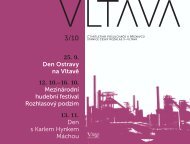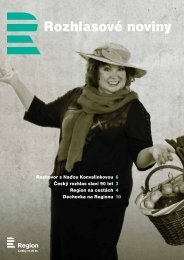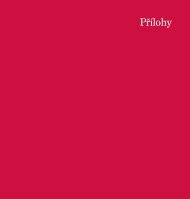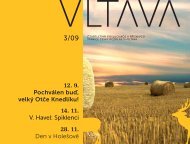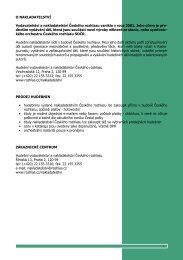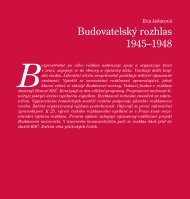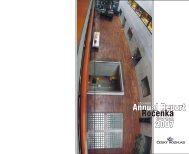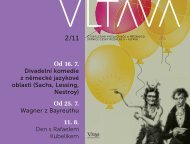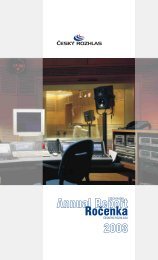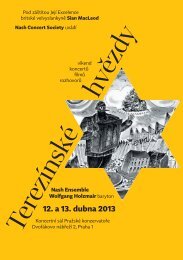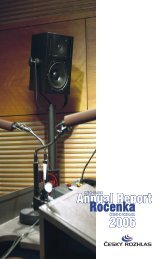Rozhlasový podzim - Český rozhlas
Rozhlasový podzim - Český rozhlas
Rozhlasový podzim - Český rozhlas
You also want an ePaper? Increase the reach of your titles
YUMPU automatically turns print PDFs into web optimized ePapers that Google loves.
12| 10| Út 19.30| Rudolfinum – Dvořákova síň<br />
12| 10| Tue 7.30 pm| Rudolfinum – Dvořák Hall<br />
position was individually influenced by an extramusical idea, which the composer wanted to express.<br />
However, Liszt was not only the “inventor“ of a new style. As a brilliant pianist he created many new<br />
stylization techniques for piano playing and he looked for and found new ways in the areas of harmony<br />
and instrumentation as well. Liszt was also a generous benefactor. His house in Weimar was where<br />
the elite European composers met and Ferenc Liszt selflessly supported many of them. His numerous<br />
piano transcriptions of his contemporaries’ works could also be regarded as the same selfless help to<br />
his composer colleagues. In the time of non-existent media and recording technology, these transcriptions<br />
contributed widely to the spread of the then latest orchestral music. The period of the oncoming<br />
Romanticism was also the time of the national awakening for many European countries. Although<br />
Ferenc Liszt was, in fact, not of Hungarian origin and did not speak Hungarian, he paid tribute to his<br />
native country in a lot of his compositions. One of them was the set of Hungarian Rhapsodies, which<br />
are loose fantasy works influenced by Hungarian – especially gypsy – folklore and are mostly divided<br />
into two sections – slow (called lassan) and fast (called friska). The most famous is Rhapsody No. 2 in<br />
C sharp Minor. Due to its popularity, orchestral arrangements as well as popular versions of this composition<br />
have been made.<br />
Fryderyk Chopin (1810–1849), whose important anniversary we are celebrating this year, was a<br />
great innovator in many areas of the musical language. Unlike the showy and a little superficial Liszt,<br />
Chopin is intimate: His innovations of piano stylization are rather minute and his new harmonic progressions<br />
are sometimes almost unrecognizable as they are concealed within the ingenious network of<br />
his music. While he was still living in Warsaw, which he left forever at the age of twenty-one, Chopin<br />
wrote two piano concertos. Due to their first editions, the first one is now referred to as the second<br />
piano concerto. It is full of original creativity, poetry and especially references to the Polish folklore.<br />
Here, Chopin’s patriotism meets Liszt’s efforts.<br />
Béla Bartók (1881–1945) looked for real Hungarian folk music by collecting songs in the country.<br />
However, unlike Liszt, he did not confuse it with the music of the gypsy communities. Like the Hungarian<br />
language, Hungarian folklore is, analogically, totally different from Central European folklore and<br />
Bartók – besides following the main streams of European music – allowed it to permeate the whole<br />
of his musical language. His Dance Suite celebrated the 50th anniversary of the merger between the<br />
cities of Buda and Pest in 1923. In this composition, which is one of Bartók’s most famous works, we<br />
can also hear references to other nations’ folk music. Monothematic ritornellos, which divide the work<br />
clearly, are inserted between its individual parts.<br />
The choreographic poem La Valse by Maurice Ravel (1875–1937) was also inspired by dance rhythms.<br />
Ravel’s composition, written at about the same time as Bartók’s Dance Suite, is a waltz. At the time<br />
when Europe was beginning to be heavily influenced by Latin American dances, Ravel wrote a bit of a<br />
sentimentally retrospective and, in terms of sound, a dazzling fantasy celebrating the famous European<br />
dance, whose glory was – at the time of the creation of the piece – already fading. Some of Ravel’s<br />
interpreters also see in this work a reflection of the composer’s feeling about all the things destroyed<br />
by WW I.<br />
8




